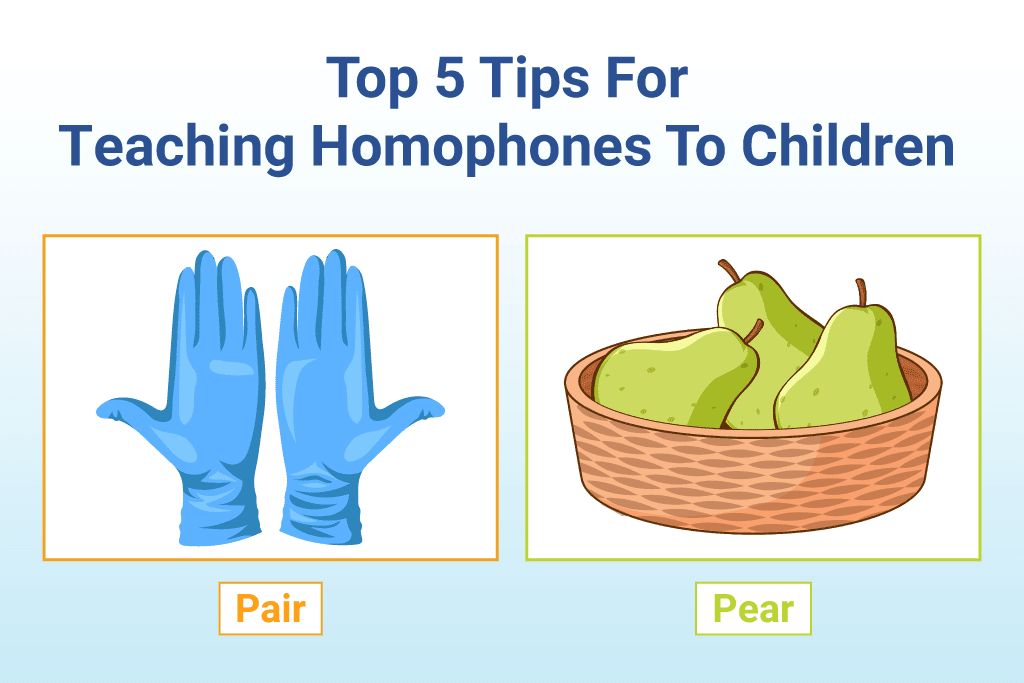Top 5 Tips For Teaching Homophones To Children

Homophones are words with the same pronunciation, but they have different meanings and often different spellings. The term “homophone” is a Greek word, where “homo” means “same,” and “phone” means “sound.”
Homophones can be confusing for children because they can be spelt differently and have different meanings. For example, the homophones “there,” “their,” and “they’re” sound the same but have different meanings and spellings.
And it is essential to use correct spelling and context when using homophones as they ensure clear communication.
Furthermore, there can be confusion between homophones, homographs, and homonyms. It can make teaching homophones challenging for tutors. However, a distinction between these three terms helps simplify the teaching process for teachers.
Ready to help your child master homophones? Discover effective teaching tips today!
A] How are Homophones different From Homographs And Homonyms?
Homophones, homographs, and homonyms are all words that sound alike, but they differ in their spelling and meaning.
- Homophones: Homophones are words that have the same pronunciation but different meanings and often different spellings. For example, “pear” and “pair” are homophones because they are pronounced similarly but have different spellings and meanings.
- Homographs: On the other hand, homographs are spelled the same but have different meanings and sometimes different pronunciations. Examples of homographs include “tear” (to rip) and “tear” (as in crying), “bow” (to bend), and “bow” (a weapon).
- Homonyms: Homonyms are homophones and homographs, meaning they have the exact spelling and pronunciation but different meanings. For example, “bat” can refer to a flying mammal or sports equipment.
Homophones, homographs, and homonyms can cause a lot of confusion to the reader or the listener. One must rely on context and pronunciation to determine its intended meaning to avoid confusion. Phonics classes for kids can help sort out this confusion and simplify the learning process for your children.
B] Learning about Homophones At An Early Age
Learning about homophones at an early age is important for developing language skills and avoiding confusion in communication. Homophones for kindergarten involve teaching children the differences between homophones to help them use the correct word in the appropriate context.
Teaching kids homophones at an early age can also improve their spelling and reading comprehension abilities.
Teachers and parents can introduce homophones through games and activities. These can involve hearing and recognizing words that sound alike but have different meanings and spellings. By providing early exposure and practice with homophones, children can develop a more robust understanding of the nuances of the English language.
Also Read : 7 Tips for Teaching Letter Sounds in Kindergarten
C] 5 Tips For Teaching Homophones To Children
Here are five tips for setting up fun homophone lessons for your children. Most phonics teacher training programs and curriculums aim at helping teachers learn how to implement these tips.
1. Start With Simple Examples
Starting with simple examples is a great way to introduce homophones to children. You can begin by choosing such words that students use daily. For instance, you can choose a combination of words such as ‘two’ and ‘too’ or ‘one’ or ‘won.’
Explain to them that the two words might sound the same but have different meanings. Use examples such as “I have two pencils.” Don’t forget to explain to them the context of the words.
For instance, “Too” means “also” or “excessively.” You can use it in sentences such as “I want to come too” or “That shirt is too small for me.” This will help kids build a foundation of understanding and clarity before moving on to more complex homophones.
2. Create/Show Visual Diagrams
Children learn best with the help of visual diagrams. A visual diagram for homophones could use a tree-like structure. A word can be at the top of the tree, branching out to show its different meanings and spellings.
For example, the word “right” could be at the top of the tree, with branches leading to “write” and “rite” to show their differences in meaning and spelling. The diagram could also use icons or images to represent the different meanings of each homophone.
To help students get better, you can conduct this process daily. It will improve their retention of the concept and words.
3. Play Games
Children love playing games, and it can be one of the best ways to engage them in learning homophones. There are many games that involve matching words with different meanings but with the same pronunciation.
- You can consider games such as Homophone Bingo, where you can create bingo cards with homophones on them and call out definitions of the homophones.
- Homophone Matching can be another game where you can create flashcards with homophones. Shuffle the cards and have children match the homophone to its definition.
- Besides these two, Homophone Charades can also be a great game to help them learn. You can write homophones on slips of paper and ask children to act out the meaning of the homophone to let other children guess.
4. Read Aloud
Reading aloud can be another ideal way to learn homophones for kids. This practice helps them recognize and understand the words in context.
You can incorporate different ways to implement this tip. For instance, pause if you come across any homophone while reading a story to kids. Explain to them the meaning of that homophone to enable better retention.
Also, when reading aloud, emphasise the differences in spelling and meaning between the homophones. After reading a sentence or passage with a homophone, repeat it and ask children to identify the homophone and its meaning.
5. Practice
Making students practise the homophones now and then will bring perfection to their knowledge. Practice is the only way they can master homophones. A few ideas that promote learning for kindergartners are using them in stories and sentence writing.
You can also create a fill-in-the-blank test for kids. Create sentences with homophones and leave a blank for the child to fill in with the correct homophone. You can also organise activities such as homophone quizzes or homophone hunts. Give children a quiz with homophones and their definitions, and ask them to match them correctly.
Also Read : 20+ Fun Phonics Activities and Games for Early Readers
Ready to help your child master homophones? Discover effective teaching tips today!
Conclusion
Homophones are an essential aspect of language that can be challenging for children to learn. As educators and parents, there are several ways to make teaching homophones more accessible and enjoyable for children.
These methods include starting with simple examples, using visual diagrams, playing games, reading aloud, and providing practice opportunities. These tips can help children understand the differences in spelling and meaning between homophones. They also help make the learning experience more engaging and interactive.
You can provide children with opportunities to practise homophones. It is crucial to reinforce knowledge and encourage children to use homophones in writing and speech.
By incorporating these methods into teaching, children can master the use of homophones and develop their language skills. If you wish to make your kids proficient with homophones, you can get in touch with Phonics Smart, we can simply learn with the help of our fun homophones lessons.

Hema Dave
Stemming from the aspiration to nurture and inspire young minds, Hema started her professional journey into education 20+ years ago. She founded 'Phonic Smart' as a trained educationist, an institute committed to equipping children with phonics skills and helping parents and teachers implement them effectively. Her diverse skill sets, encompassing teaching, teacher training, and coaching allow her to contribute valuable insights to the education industry.
